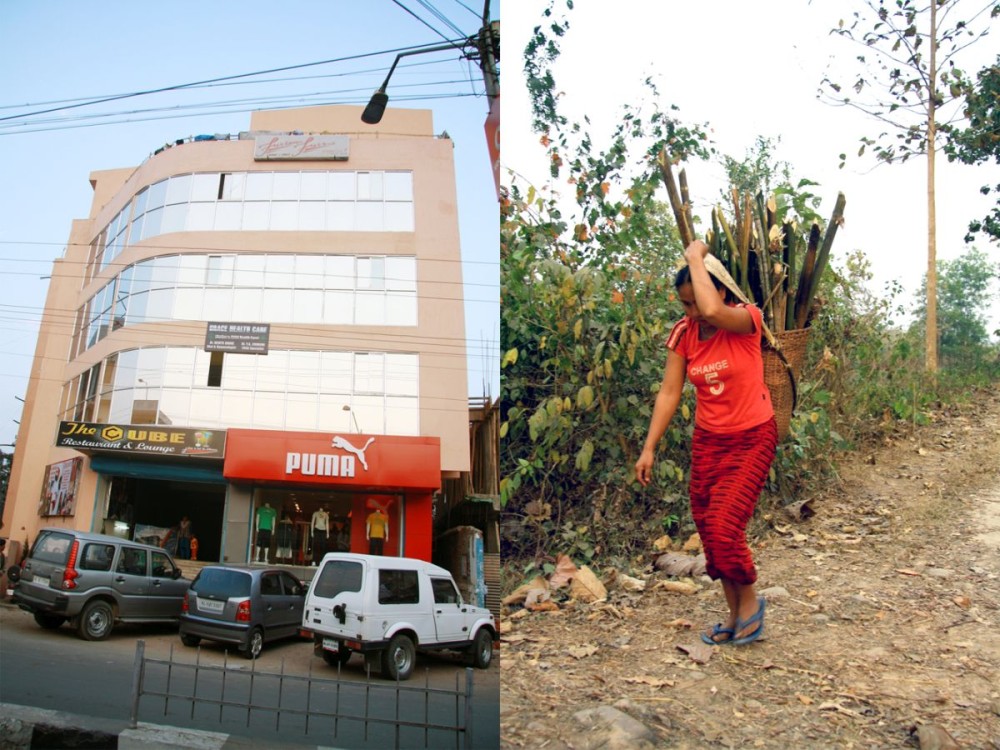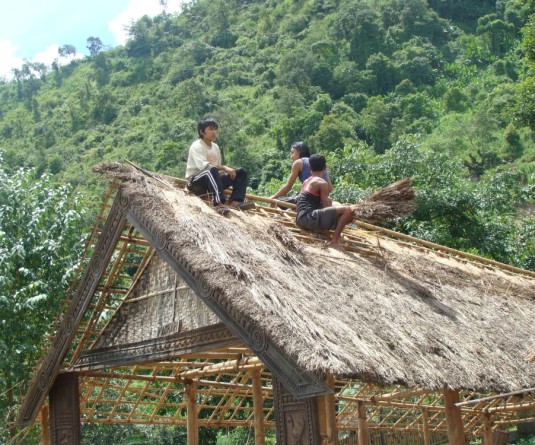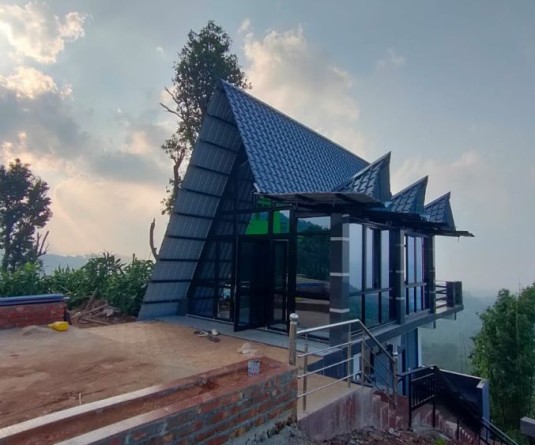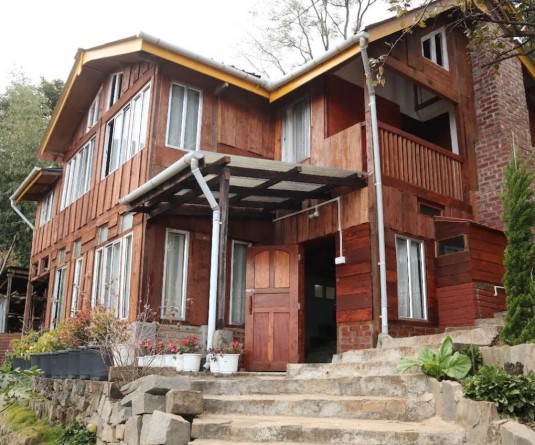Seen here are two photos vastly reflecting the two faces of Dimapur. The first one shows a few from among the countless restaurants, lounge pubs and global brands that have opened in central Dimapur while the second photo illustrates the bitter truth of the condition of the ordinary denizen of Dimapur who has to walk for miles to gather firewood for cooking. (Photos/Sorei Mahong)

Akangchila Longchar
Morung Express News
Dimapur, February 18
The Canadian communications theorist educator, writer and social reformer Marshall McLuhan said: “The suddenness of the leap from hardware to software cannot but produce a period of anarchy and collapse, especially in the developed countries.” With Dimapur, in a process of ‘development’ it is inescapably going through its period of anarchy and collapse.
“The yardstick of development for most Naga people is the number of pubs, lounges and restaurants that are being launched in Dimapur. Wearing branded clothes doesn’t make one any smarter or sophisticated, does it?” opined a journalist of a local daily paper. When Dimapur — called the most-developed town in Nagaland — has roads, railways and an airport which is a far cry to be called ‘developed,’ what of the villages that do not even have proper roads till today. The reality is that Nagaland as a whole is barely connected.
Another contender to add to the woes of Dimapur is the state of traffic. Traffic jams have become a daily affair for the citizens, to which reckless drivers add to the chaos and confusion. “Civic sense is ‘nil’ among Naga drivers and I feel there is a lot of road rage from taxi and auto-drivers,” a citizen observed. District administration and law-enforcing agencies act hapless and seems clueless to the need for proper planning.
“Nagas from the highest order to the lowest rung seems to be corrupted. Earlier we used to point fingers at politicians, ministers and the rich but today it’s sad that every single Naga seems to have a crooked mindset” expressed a citizen. Day by day one meets with instances that prove corruption, nepotism, and bribery to be ruling the very helms of every state of affair.
Serious discussions on Naga people’s spiritual faith was brought up in the year 2009. While spirituality has always been a sensitive topic, but with faith ‘spiraling downwards’ people finally felt that it was pertinent to have a critical analysis of the faith crisis. A reader of The Morung Express had commented that “Nagaland needs a reformation on its teachings, sound doctrine and evangelism which I believe only the H.S can do it with the timely revival.” An eye opening revelation was a poll conducted by The Morung Express that posted the question ‘Do you consider Nagaland a Christian state?’ to which 67% of voters said ‘No’, 15 % voted ‘Yes’ and 18% voted in ‘others.’
The gap between the rich and the poor in Nagaland is a deep wide bottomless chasm. With the continuous rise of prices in food, and primary items it is a wonder how the average person and especially those living under the Below Poverty Line (BPL) survive. Naga traditional craftsmen for decades have also been caught in a vicious cycle to earning a decent livelihood and keep their crafts alive. An idyllic place of culture and scenic beauty, making it one of the ideal tourist havens in India, yet Nagaland is still an unheard, unsung place of warriors.
Lack of proper roads and infrastructures, travel facilities from airports to railroads are the main obstacles. ‘Insurgent problems’ have also tainted it as a tourist unfriendly place. Sufficient funds for a larger tourism exposure is needed which might also help in generation of employment. The only noteworthy tourism effort has been the Hornbill festival organized by the Government of Nagaland every year in the first week of December.
Naga people have always depended on forest and agriculture for their food and all other requirements. Yet, the level of depletion and degradation of forests lands and natural habitats have been alarming. Climate change has affected Nagaland too in the form of increased scarcity of water, pollution, depleting forests area and gradual but definite environmental destruction. 2009, Nagaland underwent a drought-like situation where there was scanty rainfall which affected the production of agriculture resulting in 30-40% reduction in crop production.
The quest for gender rights has gained an important role in the society. Crimes against women have been extensively on the rise in Nagaland. Incidences of rape and murder have sadly become a daily affair. Acts like the Child Labor (Prevention and Regulation) is not being strictly enforced in Nagaland.
Nagaland University gained a new moniker as a ‘landmark of conflict’ in 2009. An institute supposed to be a centre for imparting values and breed good citizens turned into a centre of conflicts and corruption. The Retirement- superannuation issue also reared many ugly heads and was 2009s most in delectable topic. It generated so many indifferences among different sectors and not only between the young vs. the old. The 33% reservation for women issue brought put the true colors of many an organizations and individuals. Very few supported the 33% women reservation revealing the true ‘mindset’ of many Nagas.
This basic outlining of the current scenario of Dimapur brings us to the question, “Are we ready to say that Dimapur and its denizens are at an accelerating pace of ‘Development’?






